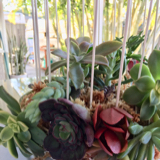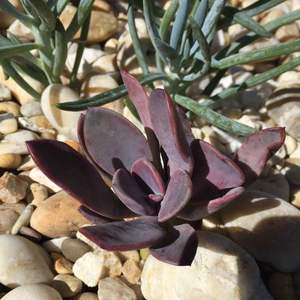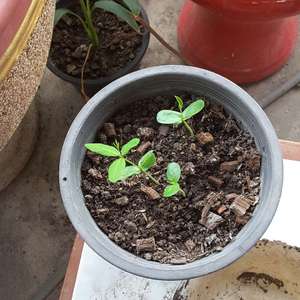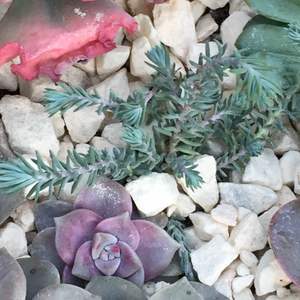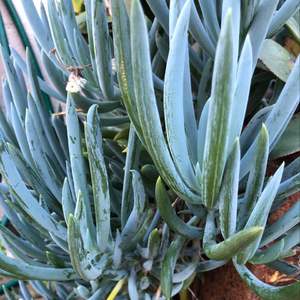文章
Miss Chen
2018年08月20日

The giant white bird of paradise plant (Strelitzia nicolai) is a cousin to the more commonly seen orange and blue bird of paradise. The 10- to 12-inch white flower has a blue "tongue" and sits inside a purple bract.

Growth Rate
According to the University of Florida, the giant white bird of paradise is a moderate grower. It eventually reaches a height of 20 to 30 feet and a width of 6 to 10 feet, although smaller specimens are commonly seen. The plants will not flower until they are several years old.
Hardiness
Hardy in USDA plant zones 9b through 11, the giant white bird of paradise is slightly hardier than its orange cousin. It can also handle drought and salt, making it a good accent plant near pools or the ocean.

Growing Strelitzia Nicolai
Full sun and warm temperatures work best for giant white bird of paradise. If grown as container plants, they need to be brought inside when outdoor temperatures drop to 60 degrees Fahrenheit. They should be allowed to dry out between waterings. Plants need to be fertilized every two weeks in spring and weekly in summer for best flowering.

Growth Rate
According to the University of Florida, the giant white bird of paradise is a moderate grower. It eventually reaches a height of 20 to 30 feet and a width of 6 to 10 feet, although smaller specimens are commonly seen. The plants will not flower until they are several years old.
Hardiness
Hardy in USDA plant zones 9b through 11, the giant white bird of paradise is slightly hardier than its orange cousin. It can also handle drought and salt, making it a good accent plant near pools or the ocean.

Growing Strelitzia Nicolai
Full sun and warm temperatures work best for giant white bird of paradise. If grown as container plants, they need to be brought inside when outdoor temperatures drop to 60 degrees Fahrenheit. They should be allowed to dry out between waterings. Plants need to be fertilized every two weeks in spring and weekly in summer for best flowering.
0
0
文章
Miss Chen
2018年07月26日

Description: This plant is an annual or biennial about 1-3' tall. Small plants are branched sparingly, while large plants branch abundantly in the upper half. The stems are gray-green or gray-blue, terete, glabrous, and glaucous. Plants that begin growth during the fall will overwinter as low rosettes with basal leaves, while plants that begin growth during the spring bolt upward almost immediately. Both the basal and lower leaves are up to 10" long and 2" across, but they are usually smaller than this. They are oblanceolate in overall shape and strongly pinnatifid with undulate or bluntly dentate margins; their terminal lobes are the largest in size. Both types of leaves have stout petioles. In contrast, the middle to upper leaves are smaller in size, lanceolate-oblong in shape, with margins that are smooth or bluntly dentate. These latter leaves have bases that usually clasp their stems, although some of them may be sessile. Like the stems, these various leaves are grey-green or blue-green, glaucous, and usually glabrous – occasionally the basal leaves have short bristly hairs. The lower, middle, and upper leaves are alternate.
The upper stems terminate in racemes of bright yellow flowers. The flowers bloom toward the apex of each raceme, while the seedpods develop below. Each flower is 1/3–1/2" (8-12 mm.) across, consisting of 4 yellow petals, 4 green to yellow sepals, several stamens, and a pistil with a single style. The sepals are narrowly lanceolate and hairless. The blooming period can occur anytime between late spring to early fall; it usually lasts about 1 month for a small colony of plants. Each flower is replaced by an ascending cylindrical seedpod (silique) that is 1¼–2¼" long at maturity and hairless. Each seedpod terminates in a seedless beak that is about one-fourth its entire length. At the base of each seedpod, there is a stout hairless pedicel about ½" long that is widely spreading to ascending. Each seedpod divides into 2 valves to release its small globoid seeds. The root system consists of a taproot. This plant reproduces by reseeding itself.
Cultivation: Rape Mustard prefers full sunlight, moist to dry conditions, and a neutral to alkaline soil containing loam, clay-loam, or gravelly material. The size of individual plants varies greatly according to moisture conditions and soil fertility.
Range & Habitat: Rape Mustard is occasional in most areas of Illinois (see Distribution Map). It is native to Eurasia. Typical habitats include cropland, weedy fields, roadsides, gravelly areas along railroads, and waste areas. This plant is usually found in areas with a history of disturbance where there is scant ground vegetation.

Faunal Associations: The nectar of the flowers attracts small bees and White butterflies (Pieridae); some bees may collect pollen from the flowers as well. The caterpillars of the butterflies Pieris napi (Mustard White), Pieris rapae (Cabbage White), and Pontia protodice (Checkered White) feed on Brassica spp. (Mustards), as do the caterpillars of the moths Evergestis pallidata (Purple-Backed Cabbageworm) and Plutella xylostella (Diamondback Moth). Several species of flea beetles (primarily Phyllotreta spp.), Murgantia histrionica (Harlequin Bug), and Adelphocoris superbus (Meadow Plant Bug) also feed on the foliage of these plants. The oily seeds of Rape Mustard and similar species are eaten by the Mourning Dove and Ring-Necked Pheasant, and the mild-tasting foliage can be eaten in limited amounts by livestock and other mammalian herbivores.
Photographic Location: A gravelly area along a railroad in Savoy, Illinois.
Comments: This is another weedy mustard species from Eurasia. It should not be confused with the agricultural crop, Oilseed Rape (or Canola), which is Brassica napus oleifera, or one of the cultivated vegetables. Rape Mustard has several common names, including Field Mustard and Birdseed Rape. In general, Rape Mustard can be distinguished from other Brassica spp. (Mustards) by its glaucous gray-blue or gray-green foliage and its clasping alternate leaves. A similar species, Brassica oleracea (Wild Cabbage), shares these characteristics, but this latter species has larger flowers (exceeding ½" across) and it is quite rare in Illinois. Oilseed Rape has foliage that is more green than either Rape Mustard or Wild Cabbage, and its foliage isn't glaucous.
The upper stems terminate in racemes of bright yellow flowers. The flowers bloom toward the apex of each raceme, while the seedpods develop below. Each flower is 1/3–1/2" (8-12 mm.) across, consisting of 4 yellow petals, 4 green to yellow sepals, several stamens, and a pistil with a single style. The sepals are narrowly lanceolate and hairless. The blooming period can occur anytime between late spring to early fall; it usually lasts about 1 month for a small colony of plants. Each flower is replaced by an ascending cylindrical seedpod (silique) that is 1¼–2¼" long at maturity and hairless. Each seedpod terminates in a seedless beak that is about one-fourth its entire length. At the base of each seedpod, there is a stout hairless pedicel about ½" long that is widely spreading to ascending. Each seedpod divides into 2 valves to release its small globoid seeds. The root system consists of a taproot. This plant reproduces by reseeding itself.
Cultivation: Rape Mustard prefers full sunlight, moist to dry conditions, and a neutral to alkaline soil containing loam, clay-loam, or gravelly material. The size of individual plants varies greatly according to moisture conditions and soil fertility.
Range & Habitat: Rape Mustard is occasional in most areas of Illinois (see Distribution Map). It is native to Eurasia. Typical habitats include cropland, weedy fields, roadsides, gravelly areas along railroads, and waste areas. This plant is usually found in areas with a history of disturbance where there is scant ground vegetation.

Faunal Associations: The nectar of the flowers attracts small bees and White butterflies (Pieridae); some bees may collect pollen from the flowers as well. The caterpillars of the butterflies Pieris napi (Mustard White), Pieris rapae (Cabbage White), and Pontia protodice (Checkered White) feed on Brassica spp. (Mustards), as do the caterpillars of the moths Evergestis pallidata (Purple-Backed Cabbageworm) and Plutella xylostella (Diamondback Moth). Several species of flea beetles (primarily Phyllotreta spp.), Murgantia histrionica (Harlequin Bug), and Adelphocoris superbus (Meadow Plant Bug) also feed on the foliage of these plants. The oily seeds of Rape Mustard and similar species are eaten by the Mourning Dove and Ring-Necked Pheasant, and the mild-tasting foliage can be eaten in limited amounts by livestock and other mammalian herbivores.
Photographic Location: A gravelly area along a railroad in Savoy, Illinois.
Comments: This is another weedy mustard species from Eurasia. It should not be confused with the agricultural crop, Oilseed Rape (or Canola), which is Brassica napus oleifera, or one of the cultivated vegetables. Rape Mustard has several common names, including Field Mustard and Birdseed Rape. In general, Rape Mustard can be distinguished from other Brassica spp. (Mustards) by its glaucous gray-blue or gray-green foliage and its clasping alternate leaves. A similar species, Brassica oleracea (Wild Cabbage), shares these characteristics, but this latter species has larger flowers (exceeding ½" across) and it is quite rare in Illinois. Oilseed Rape has foliage that is more green than either Rape Mustard or Wild Cabbage, and its foliage isn't glaucous.
0
0
文章
Miss Chen
2018年07月25日

Description: This perennial plant has sword-shaped alternate leaves about ¾–2' long; they originate primarily toward the bottom of the flowering stalk. These leaves are often grouped together into the shape of a fan; they are green to grey-blue, linear in shape, glabrous, and glaucous. Their margins are smooth, while their veins are parallel. The erect central stalk is 2–3½' tall and either branched or unbranched; it is terete, fairly stout, glabrous, glaucous, and pale green. This stalk terminates in a cyme or compound cyme of flowers. There are pairs of small linear-lanceolate bracts at each fork of the stalk; these bracts are slightly membranous and tend to wither away. Each flower spans about 1¼–2" across, consisting of 6 spreading tepals, 3 distinct stamens, a style with a tripartite stigma, and an inferior ovary. The tepals are orange with purple dots and elliptic-oblong in shape, while the ovary is green, glabrous, and narrowly ovoid. Each cyme usually produces several flowers. The blooming period occurs from mid- to late summer and lasts about 1-2 months. There is no noticeable floral scent. Each flower is replaced by an oblongoid seed capsule about 1" long; the 3 sides of this capsule become strongly recurved, revealing a mass of shiny black seeds that resembles a blackberry. The root system consists of a thickened crown at the base of the plant, which has fibrous roots underneath; spreading rhizomes are also produced. Both the crown and rhizomes have an orange interior. This plant can spread by either rhizomes or seeds.
Cultivation: The preference is full or partial sun, moist to dry conditions, and soil that is loamy, rocky, or sandy. The flowers and foliage are rarely bothered by disease or insect pests.
Range & Habitat: Blackberry Lily has naturalized throughout Illinois in widely scattered locations (see Distribution Map). In the wild, it is uncommon, although its population within the state may be increasing. Habitats include thin woodlands, rocky bluffs, hillsides, fallow fields, roadsides, and sites of old homesteads. Blackberry Lily was introduced from East Asia as an ornamental plant and it is often cultivated in gardens because of the attractive foliage and flowers.
Faunal Associations: Very little is known about floral-faunal relationships for this introduced plant. The flowers offer nectar and pollen to insects and other floral visitors, but it unclear who these visitors are. There are anecdotal reports that the seeds are eaten by birds.

Photographic Location: A flower garden at the Arboretum of the University of Illinois in Urbana, Illinois.
Comments: This remarkable plant has the leaves of an iris (Iris sp.), the flowers of a lily (Lilium sp.), and a fruit that resembles a blackberry (Rubus sp.). There is nothing that quite resembles it. The flower of Blackberry Lily has only 3 stamens, while the flower of a lily has 6 stamens. The Blackberry Lily differs from other members of the Iris family in having 3 distinct stamens that are not petal-like in appearance. It is still unclear whether the Blackberry Lily will become invasive. Another common name of this species is the Leopard Lily.
Cultivation: The preference is full or partial sun, moist to dry conditions, and soil that is loamy, rocky, or sandy. The flowers and foliage are rarely bothered by disease or insect pests.
Range & Habitat: Blackberry Lily has naturalized throughout Illinois in widely scattered locations (see Distribution Map). In the wild, it is uncommon, although its population within the state may be increasing. Habitats include thin woodlands, rocky bluffs, hillsides, fallow fields, roadsides, and sites of old homesteads. Blackberry Lily was introduced from East Asia as an ornamental plant and it is often cultivated in gardens because of the attractive foliage and flowers.
Faunal Associations: Very little is known about floral-faunal relationships for this introduced plant. The flowers offer nectar and pollen to insects and other floral visitors, but it unclear who these visitors are. There are anecdotal reports that the seeds are eaten by birds.

Photographic Location: A flower garden at the Arboretum of the University of Illinois in Urbana, Illinois.
Comments: This remarkable plant has the leaves of an iris (Iris sp.), the flowers of a lily (Lilium sp.), and a fruit that resembles a blackberry (Rubus sp.). There is nothing that quite resembles it. The flower of Blackberry Lily has only 3 stamens, while the flower of a lily has 6 stamens. The Blackberry Lily differs from other members of the Iris family in having 3 distinct stamens that are not petal-like in appearance. It is still unclear whether the Blackberry Lily will become invasive. Another common name of this species is the Leopard Lily.
0
0


